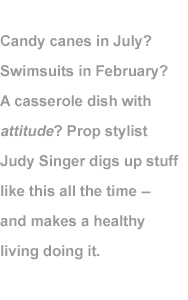 |
|
||||||||||||

|

|
|
By Judy Fireman
|
"Get paid to shop!" Dubious? You'd be naive not to be. Yet it's an apt, if incomplete, description of what Judy Singer does for a living. For 23 years, Singer has worked in New York as an independent prop stylist -- one of about 50 working there now. Her job is to find and buy the props that surround the products featured in print advertisements. Singer's area of expertise is "tabletop styling," which means that she usually works for photographers who shoot products that fit on a table (as opposed to those who are good at photographing cars or fashion models or mutant vegetables). Such typecasting is industry-wide and can border on the absurd. Singer and one photographer she works with, for example, are known as the best pen photographer/stylist team in town. Singer says she occasionally tires of trying to romance the pens, yet seems happily resigned to her fate. "Hey," she says, "if they want pens, we'll give them pens!" Food Most often though, Singer works on food projects, for which she's also established a reputation. On a typical food shoot, a food stylist cooks the food, a carpenter builds the kitchen "set," and Singer buys the dishes, the napkins, the flowers, and any other atmospheric objects required to complete the scene. Although she's hired by the photographer, Singer's instructions typically come from the art director, who -- if she's lucky -- might sketch a design on the back of an envelope. Singer's job is to interpret the art director's vision. "Often this is the hardest part of the assignment," Singer says, launching into a favorite story: One ad's concept was a sophisticated, European-looking lunch table, featuring a bowl of soup. In lieu of specific instructions, the art director offered Singer a chatty anecdote about a gorgeous Italian movie with a romantic picnic scene and concluded by saying: "You know what I mean, Judy. I want Provence... I want Italy... seduction with crusty bread, hand-crafted pottery, and, you know, really masculine cheese!" Once Singer has grasped the art director's concept for a project, she's got to get her hands on the goods, which requires more thought than you might think. For example, Singer was recently hired to work on a print advertisement for Downy's "new, improved" fabric softener dispenser -- an updated version of its previous dispenser, which was a little blue ball that you threw into the washing machine partway through its cycle. The ad campaign for the new ball dispenser suggests alternate uses for the old ones -- flower vases and lamps. The task for Singer, therefore, is to find miniature -- but real -- flowers for planting in an old dispenser and all the parts necessary to turn the ball into a working lamp. She hails a cab and zooms downtown to the lamp district, where she knows of a little shop run by an old man who can repair any kind of lamp. Alas! Closed for two weeks' vacation! What to do now? Keep a cool head: two blocks away Singer finds another old-time lamp guy who graciously spends an hour helping her assemble parts for her miniature lamp. Halfway through the lamp project now, Singer jumps into another cab to go to Bed, Bath and Beyond for tiny lampshades. No luck; they have only normal-sized lampshades. Next stop: an elegant new housewares store way uptown. On her way there, Singer stops by her favorite wholesaler in the flower district to place a tiny-flower order for 7:00 a.m. the next day -- the day of the shoot. Then it's back into another cab to continue the hunt for the ideal lampshade. Singer strikes gold at the elegant housewares store uptown. She buys four different ones to give the art director a choice, but she knows he'll go for the one colored the perfect shade of Downy blue. Mission accomplished. More Than a Savvy Shopper The Downy job incorporates, in miniature, all the skills and challenges of the prop stylist's profession. "I get a lot of snide jokes about how all I do is sail around Bloomingdale's everyday and get paid for it," comments Singer, "but Bloomingdale's is the easy part -- and actually I don't go there very often." She defines the real meat of her job in much less glamorous terms: "Styling demands three well-developed skills: one, flexible and creative problem-solving; two, the ability to work calmly under short deadlines; and three, probably the most important, the ability to listen carefully and anticipate (if not interpret or divine) the creative ideas of the art director. Oh, and good feet are also essential; and I do deduct my podiatrist bills!" Singer is amused by all the wisecracks about her work: "We stylists do shop all day, but it feels more like being on a frantic treasure hunt! For example, I need to know where to find Santa Claus swizzle sticks in July because magazines work three to four months in advance. And whether or not I like a tablecloth is completely irrelevant -- it's the art director's aesthetic that needs to be understood and interpreted."
As is true for most IPs, the prized jobs for Singer are the steady ones. For example, Singer now works frequently with one photographer for the monthly magazine InStyle. Together, they recreate a tabletop setting to accompany recipes from celebrity parties. Singer's job is to simulate, as best she can, the look of what the guests found at their tables. No matter how many times they've been called upon in the past, however, neither the photographer nor Singer can be certain that InStyle will ring again. What's regular now might well be a thing of the past tomorrow. For her speedy treasure-hunting skills, her ability to work efficiently with photographers and client art directors, and her expert sense of current trends, Singer is well compensated. Most prop stylists earn $750-$800 a day. As plush as this sounds, Singer hastens to point out that her day usually lasts longer than eight hours. Often Singer meets with the photographer and the art director a few days in advance to plan the shoot. After providing multiple props for the art director to choose from, she is expected to be on call the day of the shoot should any last-minute props be needed. And the day after the shoot, it is her responsibility to pack up any rented props and return them to their owners. "There is no such thing as an average week," says Singer. "A good week will contain three jobs, and a frantic week can produce five, when I really have to hustle to fit everything in. Then again, there are weeks without a single assignment. That's when I really have to take a deep breath and wait patiently for the phone to ring. Of course, the best way to make that phone ring is to schedule a vacation -- then they're sure to call and seduce me into postponing my trip." Evolution of a Prop Stylist Years before she earned a single dollar as a professional stylist, Judy Singer relied on her sense of style to get her work done -- first as a fashion merchandiser in a New York department store, and then as a member of a talent agency representing still-life photographers. A photographer she knew through the talent agency launched Singer's career in prop styling: he complimented her eye for style one day and invited her to work for him as a stylist. Once she accepted, assignments from other photographers came fast. "There were very few stylists working in those days and the field seemed wide open," Singer says. "And as other photographers saw the work I was doing for the first photographer, they called and invited me to do some styling for them as well. Just like that, with really minimal initial planning, my career was born."
Although Singer has been styling for a long time and has established a reputation as a reliable veteran, she doesn't take continued success for granted. She prepares for it. In addition to attending trade shows to preview the latest tabletop products, she carefully studies television advertisements and home decoration magazines. "We stylists are usually 'visual' people to begin with, so it's in our nature to pay attention to home fashion trends," Singer explains. Glamorous trappings aside, Singer has the familiar IP complaint about not always getting paid on time. She keeps meticulous records of her rental costs, prop purchases, any cash she has advanced the project, and messenger bills. For each job, she submits detailed invoices with receipts for each expense (including cab fares) within a week of the job's completion. Since she technically works for the photographer, Singer usually has to wait for the photographer to be paid before she can be paid (about 45-60 days in all). Sound familiar? Singer characterizes her situation this way: "I get well paid for my aggravation. The first photographer who hired me did so because he was sure that no one could make me cry! (And he was almost right.) I treasure the freedom to dash around town on my own, with Molly in tow. I'm convinced that this life is much better than having a crazy boss... except, of course, when an art director insists that no matter what I can't bring in any green props because his mother always insisted that green was 'his' color!" Singer is unfazed by idiosyncratic clients. "It's simple," she says. "When they throw tantrums, I just smile and nod and smile and nod. And then I go out and find the most beautiful and appropriate objects I can find, cross my fingers and pray that everyone will calm down and realize that the show must go on and that these props I've brought provide the perfect setting for the product being sold. On a good day it works." |
|||||||||||||||
|
September 14, 1999 Edited by Eric Gershon Photo/Illustration by Keith Gendel Production by Keith Gendel |
We'd love to hear your comments about this article! Judy Fireman's last article for 1099, "Beating the Night Terrors," is about getting new business from old colleagues. If you like, we'd be happy to put you in touch with her, or with anyone named in this article. | |||||||||||||||
|
| ||||||||||||||||